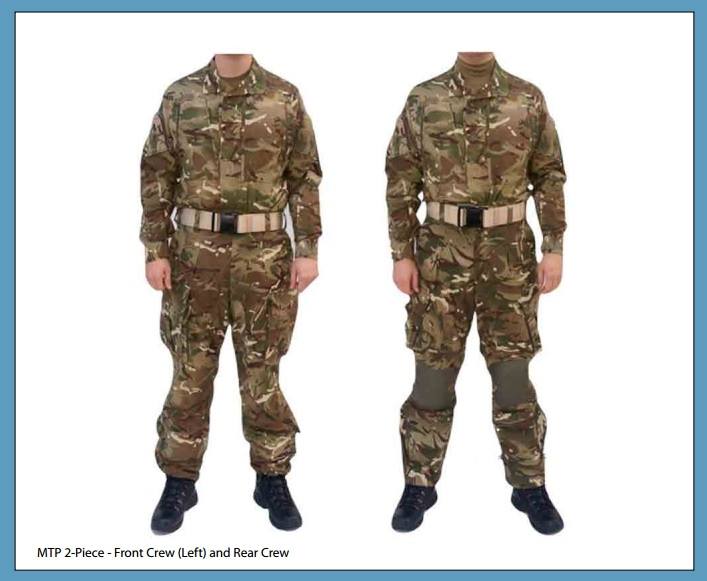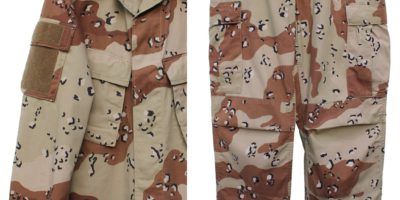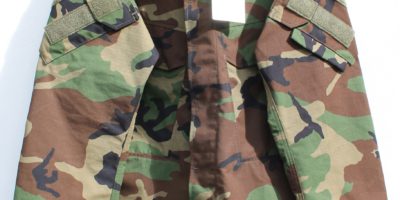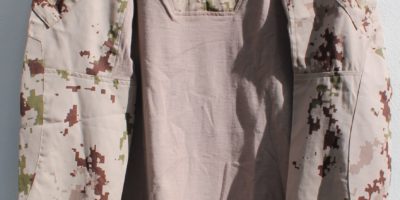One for anybody interested in British issue kit/PCS and MTP in general.
I’ve very briefly mentioned the latest aircrew FR clothing in the past, the only place I’ve seen it so far was on the aviators I worked alongside in afghan last year and the total number of items from this uniform system that are actually in existence is a minuscule number compared to the amount of standard issue PCS that’s out there in circulation now. I’m unsure exactly how many generations of aircrew specific FR apparel the military has been through since the initial roll out of MTP. I know that initially (as with the non-FR uniforms) there was a simple CS95 cut in the MTP camouflage material, at least 1 intermediate step with a unique new cut and now the ‘FACS’ (Future aircrew clothing system) items seem to have been pretty much standardised across the board.
Fast Jet and Multi engine crews retain the classic green overall for the most part, but as you might expect given the role in theatre, rotary wing crew (both drivers and ticket punchers) have the greatest expectancy of potentially having to get out of their birds in a place they’re not supposed to and their clothing, weapons and equipment shares much more in common with ground troops/crew.
The only information I could find in the public domain regards this kit is in the following 2 briefing items. First is a regular publication regards air safety and general aircrew matters (advise skipping to page 44 if you’re not a pilot), second is a Powerpoint brief that’s slightly older detailing flame resistance tests carried out on different FR MTP uniforms and the process behind how the clothing has evolved over time.
http://www.raf.mod.uk/…/DE32825E_5056_A318_A8EED74823B0BF4E…
(above link no longer functional)
http://www.safeeurope.co.uk/…/02-m-trudgill-development-of-…
The latest iteration of the FR MTP UBACS isn’t illustrated in the above unfortunately and I don’t have any pictures available, but it’s an interesting item. Having a fully-patterned torso area and full-colour loop fields on each arm, as opposed to the PYCO blanking plates on the standard general issue uniform shirts. The loop may well be normal multicam, but all examples I saw were very heavily faded; presumably a result of the combination of boil washes used by the local contractors, high frequency of washing, small number of items issued per person, the strength of the sun in theatre and lack of dye-fastness.
The trousers from this system are by far the most advanced being issued to anyone in the conventional British forces that I’m aware of. They’re extremely reminiscent of the Platatac Tac Dax Mk3 trousers, which themselves are derived from the current generation of Patagonia L9 combats that certain USSOF guys are issued.


The Patagonias have stretch on the knees like Crye combats, but instead of sewing a NYCO knee pad pocket on top of it, there’s 2 layers of the stretch fabric which accept a proprietary knee pad, foam inside, plastic piece clips on outside through holes in the outer layer of fabric. The Tac Dax and the FACS trousers do a similar thing but use the D3O Trust HP Internal knee pads. All of the above also feature stretch panels at the back just below the belt line as well as either a stretch panel or extra fabric in the groin to help lessen the chances of that splitting. The MTP stretch material has an odd horizontal ribbing to it that I’ve not seen elsewhere.
Unlike the US DoD, the UK MoD has deemed that barely anyone other than aircrew (and a few other vehicle crewmen) is worthy of getting FR clothing, even for deployment to operational theatres. You get a TON of other kit for deployment and when I went away with my bucket and spade I got the most up to date kitting for a ‘Dismounted Close Combat’ role minus the Virtus body armour and new helmet, i.e. the stuff an infantryman would’ve gotten a couple of years ago. Not because I was actually in such a role (I’d be bloody useless) it was just decided that everyone going should get all that kit, training was also far longer and more in-depth than it was during the Herrick days and everyone deployed with both a rifle with a 4x sight and a 9mm sidearm. My guess for the reasoning behind this is simply the nature of the drastically reduced footprint of international military personnel that are in country now vs the time proper to the 2014 draw down, combined with the fact that top brass and the government have “no appetite for risk” (direct quote there).
Given the high percentage of burn casualties sustained by ISAF forces in Afghanistan over the course of the large scale operations there, I find it pretty strange that wider adoption of a flame resistant uniform for everyone deploying is yet to occur. Even if features like stretch panels and integrated knee pads aren’t included for personnel not generally expecting to engage in close combat, just using a fabric with a no melt/no drip capability would be an enormous step forward. From what I can gather via my own research (military labels do not detail fabric contents of a garment) all standard PCS MTP fabric contains a very high % content of polyester, even more than most commercial PYCO blend offerings. They do include an insect repellent from the factory and there’s some sort of ballistic protective fabric in the UBACS neck which is nice; there’s also no shortage of coverage against various ballistic threats with the Mk4 Osprey and groin protector. However, when your entire lower body and your arms and shoulders have a nice layer of polyester melted to them, the best body armour in the world won’t save you from the burns and subsequent massive shock sustained.
The even more darkly comedic part of the debate for me is the fact that a lot of people in the service either don’t or won’t believe or accept this is an issue, as if somehow it’s only crew who might need the protection. Personally I scrounged up a set of the intermediate cut aircrew issue FR uniforms in a close-enough size while I was deployed by saving it from a whole load of older/outsized kit that was being disposed of. But I’m still left with no option but to cross my fingers and hope the likes of the infantry and other personnel who risk being exposed to blast/flame hazard while transiting around current and future combat zones will actually be issued a uniform along the lines of the ones that our American allies utilise:




1 Pingback